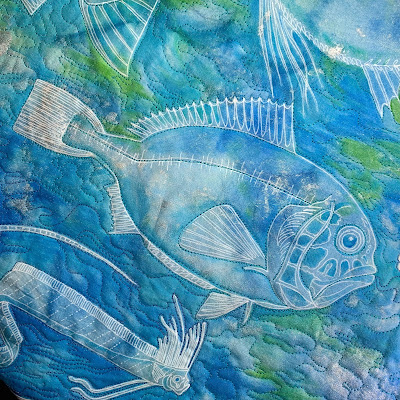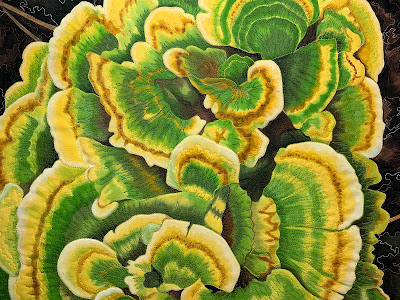What a wonderful afternoon! My friend, realtor Natalie Marrone hosted visual artists and a musician for Festa Della Terra at her home on April 23, and invited the public to stop in and drop off food for PORCH, a local hunger relief organization. This was the second Festa Della Terra. Visitors strolled through the woods and enjoyed art and music, had a beverage, and contributed to a great cause.
Tuesday, April 26, 2022
Thursday, April 21, 2022
“For Ukraine”
Copyright Susan Brubaker Knapp. 21.75 x 17.25"
White fabric, acrylic textile paint, cotton thread, cotton batting, cotton backing fabric. Wholecloth painted and free-motion machine quilted.
I started this piece as Russia started its brutal war on Ukraine. As a former journalist, I find that I am glued to the television coverage when something big is happening. As my stomach churned, I turned to painting a sunflower – a symbol of Ukraine – to help me focus and calm.
For information about my wholecloth painting process, please see my blog post here: https://wwwbluemoonriver.blogspot.com/2014/01/faqs-wholecloth-painting.html
I’ll be teaching this process May 5-10, 2023 at Empty Spools Seminars at Asilomar in Pacific Grove, California. Students will work from their own photos and learn how to paint on fabric. Details here: https://emptyspoolsseminars.com/
Here are some detail shots:
Sunday, March 27, 2022
“Beautiful Day in the Neighborhood”
 |
| Beautiful Day in the Neighborhood Copyright Susan Brubaker Knapp 2022 36" x 46.5" |
I started this piece just as Putin began his war against Ukraine, and it helped me stay busy while I watched the horror unfold on the TV. I had begun the section with the orange strips about 3 years ago, and it was in my "to-do" pile.
When I posted a photo of it in progress on social media and asked for names, it was interesting how many people linked the war to what they saw in this piece. I got lots of suggestions with things like “Incursion,” “Escape Routes,” and “Before the Seige.”
I decided to call it “Beautiful Day in the Neighborhood,” which is a nod to the Mister Rogers song that he used to open his children's TV show. (I grew up in Pittsburgh, and actually met Mister Rogers when I was four years old.) The title refers to an idealistic view of the world, in which people want to be good neighbors, and is in direct contrast to what Putin is doing to Ukraine. I believe that the good people of Ukraine and the good people of Russia want to be good neighbors. It is a dictator, his cronies, and his war machine that make it impossible. Bombs have destroyed beautiful neighborhoods where people lived, loved, and played with their children.
Here are the lyrics to Fred Roger's song:
It’s a beautiful day in the neighborhood
A beautiful day for a neighbor
Could you be mine?
Would you be mine?
It’s a neighborly day in this beauty wood
A neighborly day for a beauty
Could you be mine?
Would you be mine?
I have always wanted to have a neighbor just like you
I've always wanted to live in a neighborhood with you
Let’s make the most of this beautiful day
Since we’re together, might as well say
Would you be my, could you be my
Won’t you be my neighbor?
Sunday, March 13, 2022
Let's raise funds for World Central Kitchen!
Tuesday, March 8, 2022
Blue Water Film Festival
“Net of Wonder” is a piece I made for the exhibition “A Better World: Heroes Working for the Greater Good,” and celebrates the work of Jacques-Yves Cousteau (1910-1997), an explorer and environmentalist passionate about the sea and everything that swam or crawled in it. He helped develop the first scuba equipment, which enabled researchers to more closely study underwater environs. Cousteau warned us about the dangers of coastal development, pollution, exploitation, and over-fishing. His life was one of extraordinary passion and purpose. “The sea,” Cousteau said, “once it casts its spell, holds one in its net of wonder forever.”
As a child, I loved watching “The Undersea World of Jacques Cousteau,” a TV show that aired in the U.S. from 1966 to 1976. In the Calypso, a former French naval vessel, and in his little yellow submarine, Cousteau took me to places I will never be able to visit. He opened my eyes to the diversity and splendor of the ocean, and the need to protect it.
Tuesday, March 1, 2022
“Native Beauties in Fabric and Thread”
In lieu of a reception, I’ll meet with visitors and demonstrate techniques I used to create these 15 pieces on April 2. Please come; I’d love to meet you!
Wednesday, January 26, 2022
Oaks
Wednesday, January 19, 2022
Turkey Tail Fungus
 |
“Turkey Tail Fungus” Copyright Susan Brubaker Knapp 2022 20.75 x 25.5" |
White cotton fabric, acrylic textile paint, cotton batting, interfacing, cotton backing, cotton thread. Wholecloth painted, free-motion quilted.
Friday, December 17, 2021
“Pink Coleus” on Mancuso site
Here’s the whole piece:
Studio Tour Video
Our wonderful realtor, Natalie Marrone, who helped us find our home here in Chapel Hill, made a video for her business that features me! The idea was to tell folks interested in moving to the area about our active arts scene.
Saturday, November 27, 2021
Witch Hazel
 |
| “Witch Hazel” Copyright Susan Brubaker Knapp 2021. About 26x21”. Wholecloth painted, free-motion machine quilted. |
Hamamelis virginiana (Witch Hazel) is a species of flowering shrub native to eastern North America, from Nova Scotia west to Minnesota, and south to central Florida to eastern Texas.
The information below is from Larry Stritch of the U.S. Forest Service:
American witchhazel posses some interesting lore and uses. The most interesting use as been the use of forked limbs as dowsing or divining rods. Early European settles observed Native Americans using American witchhazel to find underground sources of water. This activity is probably where the common name witchhazel came from. “Wicke” is the Middle English for “lively’ and “wych” is from the Anglo-Saxon word for “bend.” American witchhazel was probably called a Wicke Hazel by early white settlers because the dowsing end of the forked branch would bend when underground water was detected by the dowser. This practice had a widespread use by American settlers and then exported back to Europe. Dowsing became an established feature of well-digging into the 20th century.
From Wikipedia:
Native Americans produced witch hazel extract by boiling the stems of the shrub and producing a decoction, which was used to treat swellings, inflammations, and tumors.[6] Early Puritan settlers in New England adopted this remedy from the natives, and its use became widely established in the United States.[7]
An extract of the plant is used in the astringent witch hazel.
H. virginiana produces a specific kind of tannins called hamamelitannins. One of those substances displays a specific cytotoxic activity against colon cancer cells.[8]
The bark and leaves were used by Native Americans in the treatment of external inflammations. Pond's Extract was a popular distillation of the bark in dilute alcohol.



























































